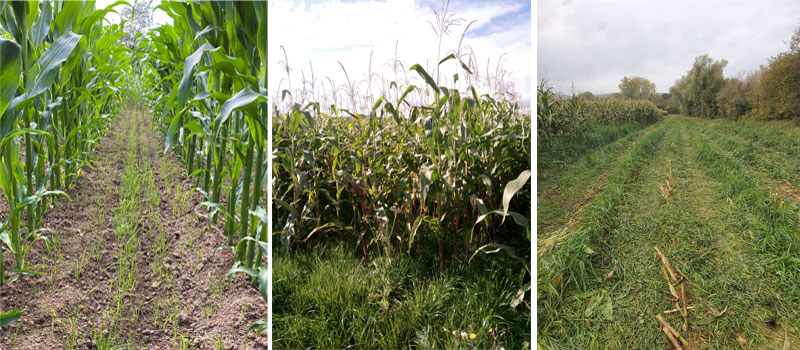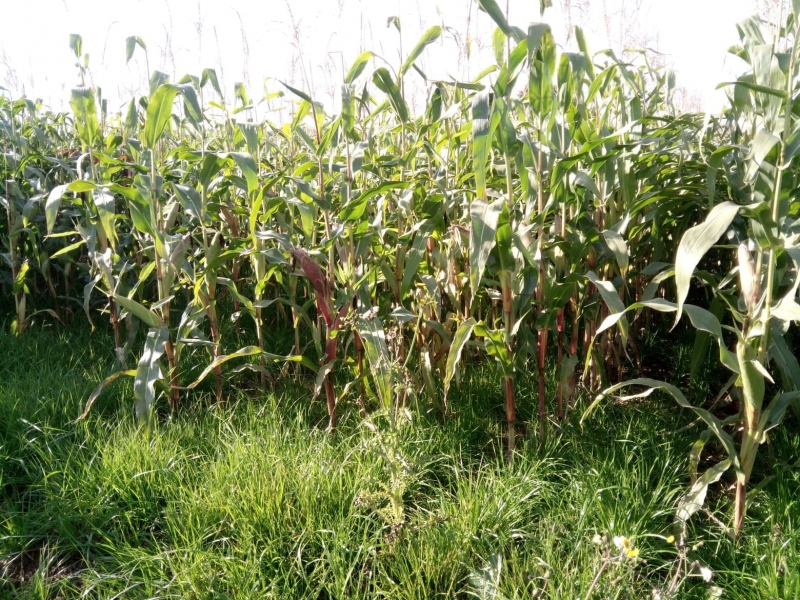Undersowing maize at Ewkin Livestock
The Herefordshire Natural Flood Management (NFM) construction grant scheme aims to reduce flood risk to local communities, as well as improve water quality and enhance biodiversity, using natural flood management processes.
The scheme runs until March 2027 and provides funding to help support landowners and farmers to alter their land and water management practices to slow the flow of water and reduce flood risk to downstream communities.
View the NFM construction grant scheme for more details and eligibility
Undersowing maize case study

Maize undersown with grass at early growth, full growth and after harvest.
"No impact on yields or ability to harvest the maize." "Less runoff into local ditches."
Jacob Barker, Ewkin Livestock
What is undersowing maize?
This NFM technique involves undersowing the maize crop with grass to ensure the ground remains covered after the maize has been harvested.
What are the benefits?
- Flood risk reduction - By preventing fields being left as bare earth and stubble, the grass is able to help slow the flow of water across the ground surface. It also helps to improve the soils structure and soil infiltration rates, helping to reduce flood risk to downstream communities.
- Reduced soil erosion – cover crops provide protection from wind and rain.
- Reduced nutrient losses – improved soil structure and infiltration rates help to reduce nutrient losses from the soil.
- Aesthetically pleasing – no bare ground
- Grazing opportunities – once the maize has been harvested, the grass provides opportunities for grazing on land which would have previously been bare earth.
“Less mud is dragged onto the road during harvesting due to ground travelling better" "Where the grass has come through well the ditches are running clear.” “Greater carbon capturing ability of the soil.” “We will continue undersowing our maize with grass.”
Jacob Barker, Ewkin Livestock
Site details
- Location: Ewkin Livestock
- Water course: Brimfield brook
- NFM Project Catchment area: Brimfield brooks
- Ownership: P. Dobson, T. Whiting, D. Foulkes-Jones and H. Roper, Ewkin Livestock
- Designations: None
- Protected species: None
Story at Ewkin Livestock
Ewkin Livestock is an arable farm in the Brimfield brook catchment which grows maize to supply to the local anaerobic digester plant. Before they had a visit from Hannah, one of Severn Rivers Trust’s Catchment Advisors, the farm grew their maize following standard practice. This involves sowing the maize crop on its own, meaning that for long periods of time the ground is left bare or exposed, increasing the risk of soil erosion, compaction and surface water runoff.
Following advice from Hannah, in 2019 Ewkin Livestock applied to undersow 6.9 ha of maize. This involved planting a grass crop with the maize crop, meaning that the field had cover all year around, helping reduce the risk of soil erosion, compaction and surface water runoff. Based on the performance of this crop, the farm decided to undersow a further 35.74 ha of maize in 2020. Jacob at Ewkin Livestock tells us that the farm plans to “continue undersowing our maize with grass”, helping to reduce flood risk to the downstream communities of Orleton and Brimfield.

NFM details
What was implemented?
- 42.64 ha of maize under sown
Costs
- River Wye and Lugg NFM Project Construction Grant Scheme value of £87/ha @ 50% grant contribution rate (NFM05): £1,854.84
- Landowner contribution of 50%: £1,854.84
- Total cost: £3,709.68
Who did the work?
- Local contractors
Consents
- None required
Interview with the landowner
Jacob Barker at Ewkin Livestock gave us this useful insight into the works on his farm.
How did you find out about the River Wye and Lugg NFM Project?
We found out about the River Wye and Lugg Natural Flood Management project through a sheep farmer who wanted winter grazing.
What has the funding enabled you to do?
Make the undersowing job financially profitable so we’re able to sustain doing the job next year.
What changes to your land have you noticed since implementing the Natural Flood Management?
Contractors reported the ground was easier to work down in the spring meaning the soil hadn’t capped.
What are the impacts to your business? for example, the impact on yield?
There has been no impact to maize yields or ability to harvest the maize.
What are the benefits to the wider community?
Greater carbon capturing ability of the soil. Less mud dragged on to the road during harvesting due to ground travelling better.
Have you observed any other benefits from the NFM work? e.g. reduced soil runoff
Less water runoff into local ditches. Less mud dragged onto road as ground travelled better.
Have you seen the NFM working during a heavy rainfall event, if so what did you notice?
Where the grass has come through well the ditches are running clear. Water isn’t creating pathways straight to the ditches (reducing soil erosion)
How have you found the experience?
Grant system has been easy to apply for and monies have come through when promised. Undersowing is aesthetically pleasing.
Will you continue to adopt Natural Flood Management practices in the future? If so which ones?
Yes – we will continue undersowing our maize with grass
Herefordshire Council would like to thank all involved for their support with implementing NFM at Ewkin Livestock. This work forms part of the Defra funded River Wye and Lugg Natural Flood Management Project.

